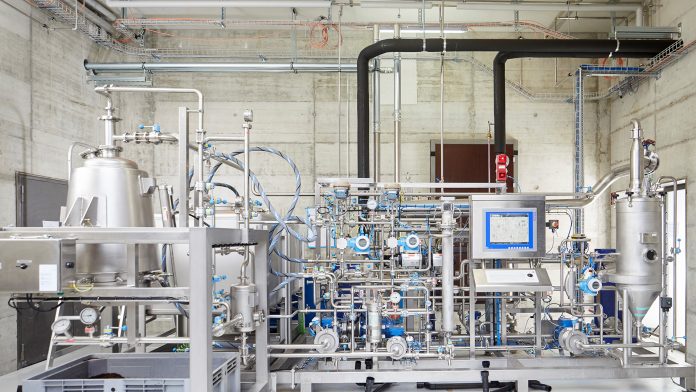With their pilot plant for the production of extracts from indigenous forest biomass, the BFH and Schilliger Holz AG have set a milestone in the development of a new value-added chain for the forestry and wood industry.
For the first time, it is possible to produce biomass extracts in sufficient quantity and quality for the development of technologically mature applications. Extraction processes are also being tested in a pilot phase. The aim is to adapt them to an industrial production scale.
From the laboratory to industrial maturity
From 2015 to 2018, based on the National Research Programme ‘Resource Wood’s’ (NRP 66) TannEx project, scientists at BFH demonstrated the chemical composition of conifer bark extracts for the first time. They also determined the influence of the extraction parameters on the chemical composition. The results indicate that hot water extraction allows the cost-effective production of substances from the bark and wood of indigenous coniferous species (spruce, fir, pine, and larch), but also from certain hardwoods such as chestnut and oak. Within the framework of Innosuisse projects, a number of products for various markets have been developed or are being developed at BFH using such extracts.
However, the validation of these applications on a pilot scale has so far failed, mostly because extracts from suitable processes were not available in sufficient quantity and quality. The new pilot extraction facility planned for the BFH site in Biel (Switzerland) is intended to close this gap. The infrastructure project, which is being carried out jointly by the Bern University of Applied Sciences and Schilliger Holz AG, is supported by the Federal Office for the Environment. The plant successfully started in December 2020.
The pilot biomass plant as a key element
The infrastructure of the plant itself enables certain substances to be obtained from forest biomass and sawmill residues on a pilot scale. The water- and solvent-based extraction processes mainly isolate phenolic substances (phenolic monomers as well as condensed oligomeric polyphenols or ‘tannins’). The capacity of the plant makes it possible to process a maximum of 50kg of biomass per day. In a second step, the highly concentrated extracts obtained can be dried into powder form.
Additional technology units are already available at BFH for the following process steps:
- Shredding;
- Steam explosion;
- Membrane filtration;
- Vacuum drying; and
- Spray drying.
This provides the BFH with an infrastructure that can be used for a wide range of tasks in the extraction of substances from forest and agricultural biomass. These facilities offer unprecedented opportunities to implement processes and produce substances on a pilot scale. This will enable the university to position itself even better – nationally and internationally – as a competent scientific partner in research and development, but also as a site for the development and scaling up of technologically mature processes.
Process flexibility and easy scaling up
For the plant to be realised, the project partners benefited from DEVEX GmbH’s many years of experience, which meant that it is able to implement BFH’s requirements in a suitable form. In this context, attention was paid to the flexibility in terms of being able to process a wide variety of raw materials with the appropriate parameters. In recent years, unique know-how has been developed at BFH in this area: it enables raw materials to be processed in such a way as to guarantee the desired qualities of the end product. It was also important that the processes could be scaled up as easily as possible for industrial production facilities. The pilot plant offers this possibility thanks to a technical architecture that corresponds to those of much larger plants.
Possible products and applications
The sustainably produced extracts and the phenolic compounds they contain can provide full biological chemical elements or replace a range of synthetic oil-based compounds in different applications:
- Phenol replacement in phenol-formaldehyde resins;
- Formaldehyde-free tannin-based duroplastic binders for the production of building materials
- Replacement of synthetic biocides or biostatic products in various applications by bioactive phenolic extracts;
- Use of the extracts as vegetable tannins in leather tanning; and
- Use of the extracts as bioactive additives for livestock feed.
Please note, this article will also appear in the sixth edition of our quarterly publication.





